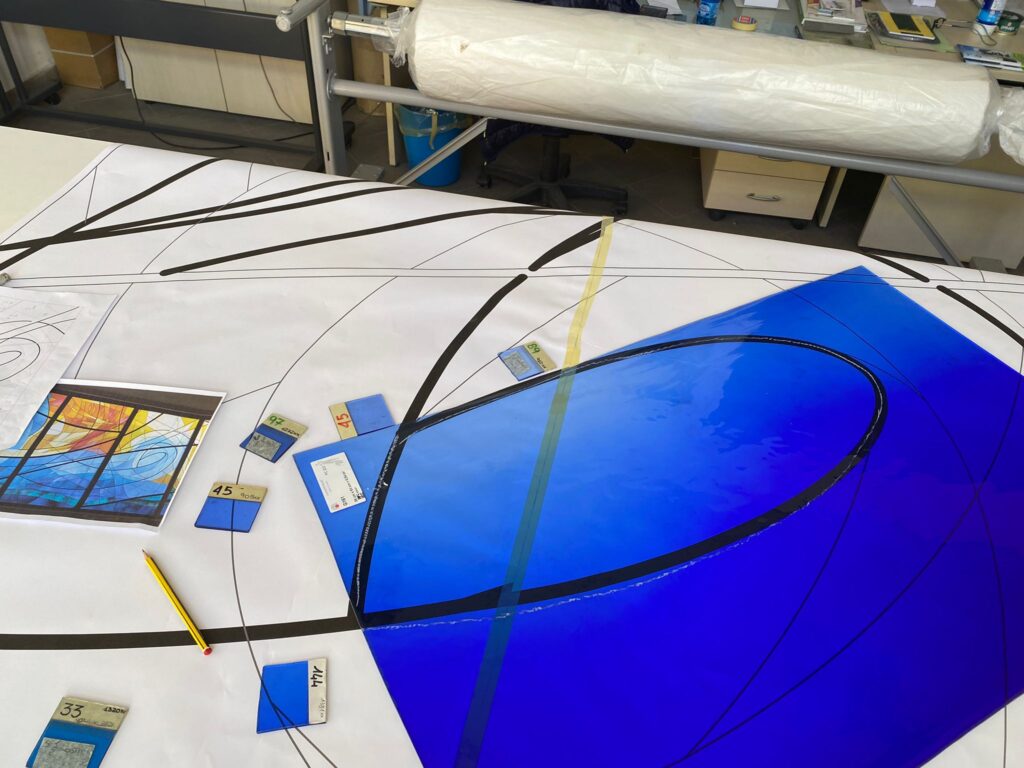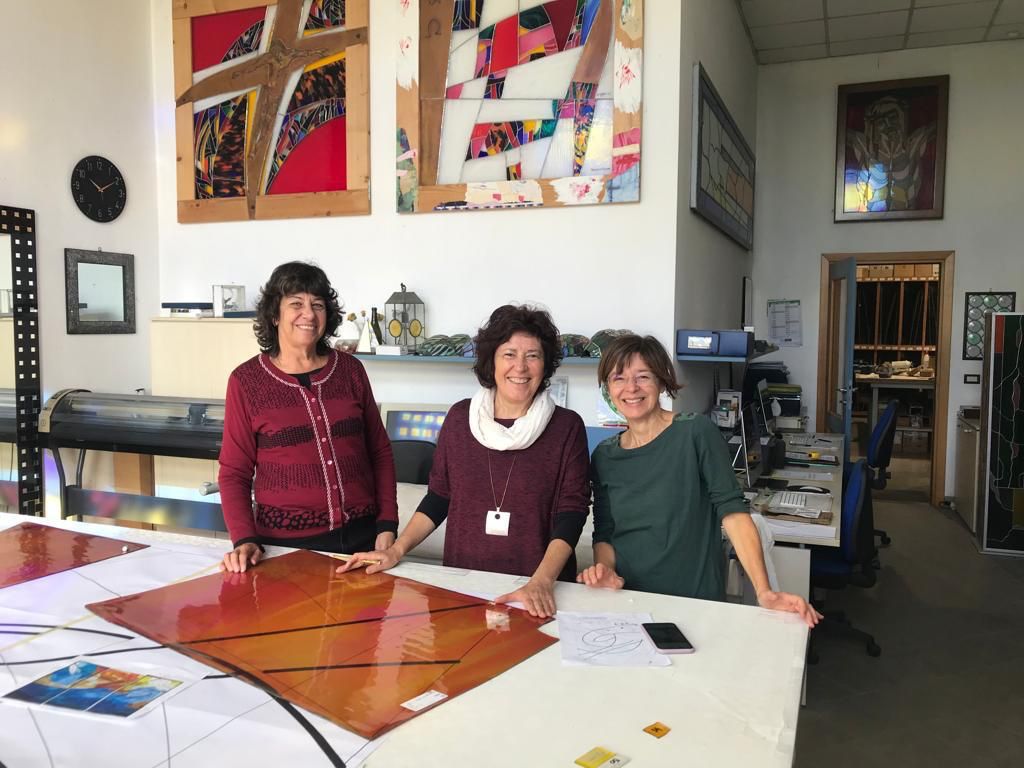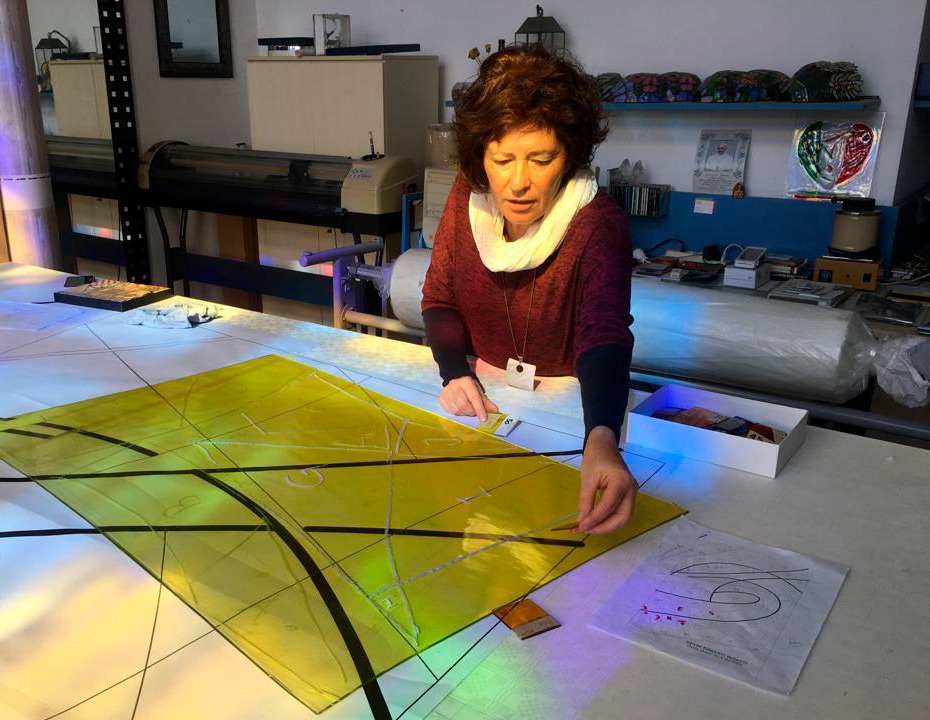Dina Figueiredo is a Portuguese painter, creator of the stained glass windows of the Maria Theotokos Shrine. We learn from her here the status of the reconstruction work underway on the Shrine, her outstanding collaboration with the Ave Art Center, and her passion for art, light and its reflections.
“I was born in a small village of 40 houses, Casal de Alho, a few kilometers from Nazaré, on the Atlantic Ocean,” says Dina Figueiredo. Born in 1964, Dina is a Portuguese painter and creator of the stained glass windows of the Maria Theotokos Shrine in Loppiano.
It was last August 18th that a storm shattered some of these windows. Today, while she lives in the Focolare of Lisbon and her personal as well as professional life takes place mainly on Portuguese soil, one finds her works – stained glass windows, mosaics, tabernacles and other liturgical elements – in churches and chapels in Spain, Italy, Japan, Korea, Ireland and Panama.
Memories, in pictures
She has collaborated with the Ave Art Center since 1991, but her passion for light and color comes from her childhood. “Ever since I was little, I liked to observe the reflections of light, the diversity of colors in earth freshly plowed; I felt (these things) were alive,” Dina recalls. She adds, “In winter, we often went to the seaside. The waves were five meters high and would reach the houses. I liked to stay late, watching the sunset over the sea. I loved those strong colors: the blues, purples, oranges and yellows. I use very little red in my windows, I hardly use green, but those other colors I think I picked up from the ocean.”
At age nine, Dina lost her father: “For a long time I felt like someone who simply carries her books to school and then brings them back home again.” Some time later, she was invited to a Mariapolis, and there, during a game, a phrase by Chiara Lubich caught her attention: “One who does not study is irresponsible; one who studies only to get good grades is proud; one who studies to do the will of God is a gen, someone who believes in a united world.” It was then that she, who had wanted to drop out of school because there was no high school in her town offering courses in art, decided to move and live on her own. A few years later, she enrolled in the Faculty of Fine Arts in Porto. However, in1985, the defining year for her vocation, she attended Genfest. “Seeing Chiara enter, seeing John Paul II…. The light I received transformed me: I didn’t feel I was there with so many people. I felt that I was alone with Jesus. When I attended the university, I dreamt of doing great things…. Over the years, also in the focolare, I understood that I had to do my part in little ways because in this way, God can act. And it is He who does great things!”.

The stained glass windows of Maria Theotokos Shrine
Dina departed for Loppiano where she would spend the next 23 years, sharing with the Ave Art Center the great adventure of building the Loppiano Shrine. “At first, I was supposed to do only the central stained glass window. But then, in order to give greater harmony to the whole, I took care of the two sides as well: the Stations of the Cross and the Via Mariae (Way of Mary).”
To do this work, Dina withdrew to meditate and find inspiration. “It was a struggle against time! Elda Pardi, at that time co-responsible for Loppiano, one day told me, ‘Dina, you have to be patient with us. Sometimes we think that it’s just enough to drop a token and the artwork comes out!’ Dina continues: “For me it was like delving deeper and deeper into the earth to find water.” She recalls that for the stained glass window to the left of the altar, it was decided to depict the mystery of the Passion instead of the Stations of the Cross. “Chiara Lubich, at that time, had received a piece of property in the Holy Land, where the so-called “Roman Staircase” was located. According to one tradition, Jesus, on the evening of the Last Supper, on his way down these steps to the Garden of Gethsemane, said the prayer for unity: ‘Father, may they all be one.’ We had gone to Rome and during a meeting we saw photos of the grounds, with the cypress and olive trees that made one think so much of Tuscany. There, I rejoiced! It was like beginning to see once more at a time when you hadn’t been able to see.”
And on the stained glass window of the Via Mariae (Way of Mary) Dina comments: “I am more abstract than figurative, so it was not easy for me to represent Mary. I even had someone with a cloak posing for me. When I prepared the stained glass window dedicated to “Mary, the Word Lived,” I depicted her as an abyss of love, and some people didn’t understand it. But for me, it was the most meaningful representation and it continues to be so!”

After all this work, who knows what it must have felt like to see it shattered, literally? Dina, in a voice that exudes sincere serenity, says: «“I think the solidarity that has come in such a strong way from all over the world, makes one think not of the damage done, but of the hope of what can be rebuilt. For me, it is a grace to have been able to come back often and to have been able to hear what this work builds in those who see it. By now, it is no longer just ‘mine’; it belongs now to a ‘body’!”.
Now, work is underway to rebuild the window of the Assumption and the window depicting Mary who lived the Word fully. The forecast is to finish them by December. “I just returned from a trip to northern Italy to start the work. We have already chosen the blown glass, which is coming from Germany. They will be precious, with some transparencies and blending in very vibrant colors. Meanwhile, the fixtures are being finished. I will oversee the work from Portugal and, if necessary, I will be on the road!”

